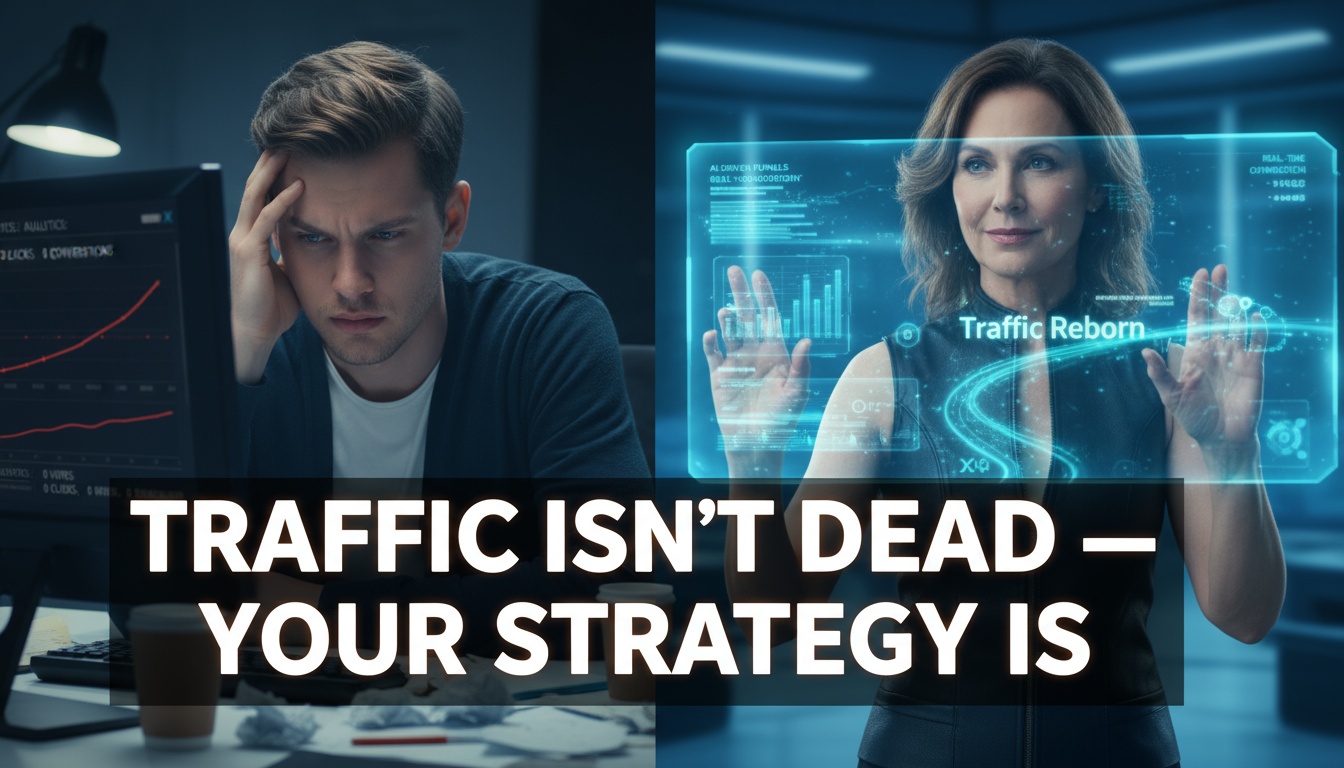My inbox was emptier than a boot camp barracks at dawn. For weeks, my latest campaign—a carefully crafted funnel, multiple email sequences, even a few paid ads—had gone completely ignored. I was convinced, for a moment, that online traffic had simply vanished overnight. Of course, that’s not what happened. Much like a lucky coin at the bottom of a foxhole, the leads were just better hidden. If you’re a veteran, you know what it’s like to size up a terrain, adapt to the unknown, and get creative under fire. So why do we follow outdated marketing tactics that wouldn’t last a single deployment? Let’s shed the digital dead weight and hunt for traffic with a fresh, battle-tested playbook.
1. Traffic Isn’t Dead: Why Marketers Mistake Silence for Defeat
Let’s be honest—there’s nothing quite like that eerie silence after you launch a big campaign. You’ve poured your energy into the perfect funnel, hit “publish,” and then… crickets. I know that feeling all too well. As a veteran business owner, I’ve seen it happen to even the most seasoned marketers. The panic sets in. You start questioning your offer, your message, and maybe even your entire business. But here’s the truth: traffic isn’t dead. It’s just gone tactical, hiding from the same old digital marketing tips that everyone else is still using.
Most entrepreneurs mistake this silence for defeat. They think their audience has vanished, or that the market is “saturated.” But if you’ve ever been on a recon mission, you know that just because you can’t see the enemy doesn’t mean they’re not there. The same goes for online communities and digital audiences. They’re not extinct—they’re just hiding from predictable, outdated ploys.
Why Entrepreneurs Panic at the Sound of 'Crickets'
When I first started in digital marketing, I expected instant results. I’d hit “go” on a campaign and wait for the floodgates to open. But more often than not, there was just silence. It’s easy to panic. But over time, I realized that silence isn’t a sign of failure—it’s a signal. It means your audience is out there, but your approach isn’t reaching them where they actually gather.
Russell Brunson nailed it in Traffic Secrets:
“Algorithms change, but human psychology doesn’t.”
Traffic is people, not pixels. If you’re only chasing the latest algorithm hack, you’re missing the bigger picture. Platforms come and go, but people—your dream customers—are always somewhere online, talking, sharing, and searching for solutions.
Traffic Isn’t Extinct—It’s Gone Tactical
Think about it: there are 19 million U.S. veterans and 37 million in the broader military community. That’s a massive audience. But they’re not just hanging out in plain sight. They’re in niche Facebook groups, specialized forums, and private Slack channels. They’re following influencers, subscribing to YouTube channels about financial freedom, and discussing side hustles on Reddit.
As a veteran business owner, you already have the observation and adaptability skills that set you apart. In the military, success depends on knowing the terrain and understanding where the action is. In digital marketing, it’s no different. The real secret isn’t in the latest tool or platform—it’s in knowing where your audience is hiding and why they act the way they do.
Drawing Parallels: Recon on the Battlefield vs. Digital Audience Research
Just like a recon mission, digital marketing starts with research. Before you ever launch a campaign, you need to know:
Who your dream customer is (fellow veterans, aspiring entrepreneurs, busy professionals)
Where they spend their time online (specific groups, podcasts, channels)
What conversations they’re already having
Instead of broadcasting your message everywhere, you infiltrate the right conversations. You show up where your audience already trusts the environment. This is where veteran business owners have a natural edge—your training has taught you to observe, adapt, and execute under pressure. You know how to scan the digital terrain for signs of life, rather than relying on outdated, one-size-fits-all tactics.
So, the next time you hear silence after a campaign launch, don’t retreat. Remember: traffic isn’t dead—it’s just hiding from lazy marketing. Use your veteran instincts. Get tactical. Find your audience where they’re already engaged, and you’ll never run out of leads.

2. Dream Customers: Who Are You Really Fighting For?
If I could go back and save myself months of frustration as a veteran business owner, it would start with this: Don’t launch a single funnel, post, or ad until you know exactly who you’re fighting for. In the world of content marketing and digital marketing strategy, this is the secret that most veteran entrepreneurs overlook—and it’s why so many campaigns fall flat.
“No marketer should publish content without knowing exactly where their dream customers are hiding.”
Inventing Your Dream Customer—Not Copying Someone Else’s Avatar
Let’s be honest: it’s tempting to swipe a generic customer avatar from a marketing course and call it a day. I tried that myself. I once blasted cold emails to everyone from accountants to yoga teachers, hoping something would stick. The result? Crickets. Zero engagement. It felt like shouting into the void.
That awkward moment taught me a lesson: you can’t copy-paste your way to connection. Your dream customer isn’t just a demographic—she’s a living, breathing person with real struggles, values, and dreams. For veteran business owners, this often means serving people who share a piece of your own journey. Maybe it’s:
Fellow veterans transitioning to civilian life and craving financial independence
Busy professionals desperate for automation over burnout
Families searching for a side income that won’t vanish in a government shutdown
When you invent your dream customer, you’re not just filling out a worksheet. You’re clarifying who you want to help—and why. This clarity shapes every offer, every headline, and every story you share. Knowing your ideal audience is the overlooked secret to digital growth.
Applying Military Recon: Observe Before You Act
Here’s where your veteran training gives you a tactical edge. In the military, you’d never storm a hill without recon. The same goes for digital marketing strategy. Before you publish, observe where your dream customers already gather. What do they talk about? What keeps them up at night?
Russell Brunson’s “Dream 100” concept is pure gold here. Instead of broadcasting your message everywhere, you create a hit list—the top 100 places your audience hangs out online. For me, that meant:
Facebook groups for veterans launching online businesses
YouTube channels focused on financial freedom and automation
Reddit threads where side hustlers swap war stories
Stop wasting ad dollars on the masses. Start infiltrating the right conversations—where your dream customers already trust the terrain.
Why Most Entrepreneurs Fail: Skipping the Dream Customer Step
Brunson says it best: most entrepreneurs fail because they never define who they’re actually talking to. I’ve seen it firsthand—offers that flop, content that goes ignored, and funnels that never convert. It’s not because the market is dead. It’s because the message isn’t sharp enough to cut through the noise.
When you know who you serve, everything changes:
Your offers become irresistible—because they solve real problems
Your content marketing speaks directly to the heart of your audience
Your engagement skyrockets, because people feel seen and understood
Dream 100: The Secret Mission to Locate, Not Broadcast
Think of your Dream 100 as your recon map. These are the podcasts, groups, influencers, and forums where your audience already gathers. Your mission isn’t to shout louder—it’s to show up where your dream customers are already listening.
As a veteran business owner, your story is your superpower. Veteran entrepreneurs bring authentic stories that draw like-minded customers. When you define your dream customer and go where they’re hiding, you don’t chase traffic. You attract it—quietly, consistently, and with purpose.
3. Skip the Megaphone: Go Where the Conversation’s Already Hot
Let me take you back to a moment that changed my entire approach to online growth. I remember lurking in a Facebook group for veteran entrepreneurs, feeling like I was eavesdropping at the back of a crowded mess hall. Everyone was swapping stories, sharing resources, and asking for advice. I watched for weeks, not wanting to butt in or come off as “that guy” pitching his latest offer. But then, I started chiming in on threads where I had real experience—automation tips, side hustle ideas, even the occasional war story. Suddenly, people started tagging me for advice. That’s when I realized: you don’t need a megaphone. You just need to join the right conversations.
Stop Shouting Into the Void: Infiltrate the Right Conversations
'Stop shouting into the void; infiltrate the right conversations.'
Most business owners waste thousands on ads, hoping to blast their message far and wide. But here’s the secret: your dream customers are already talking—you just need to show up where the conversation’s hot. Social media engagement isn’t about volume; it’s about precision. If you want to outsmart the noise, you need to find the watering holes where your audience gathers and blend in like a pro.
Where Are These High-Impact Online Communities?
Facebook Groups: Especially those for transitioning service members, veteran entrepreneurs, or niche business interests. These are goldmines for genuine connection and high-impact marketing—no massive ad spend required.
YouTube Channels: Think channels focused on financial freedom, automation, or veteran success stories. The comments section is often more valuable than the video itself.
Podcasts: Guesting on or engaging with podcasts that your audience already trusts is a shortcut to authority and trust.
Reddit Threads: Subreddits on side hustles, AI automation, or military transitions are buzzing with unfiltered questions and honest advice.
These are the places where social media engagement and networking groups overlap, creating the perfect storm for organic growth. Think of them as your “Dream 100”—the list of pages, groups, and channels where your audience lives, breathes, and buys.
Organic Infiltration vs. Wasted Ad Dollars
Here’s a hard truth: dumping money into ads before you’ve earned trust is like parachuting into enemy territory without a map. Paid traffic has its place, but only after you’ve proven your message and built authority. Organic infiltration—joining the right online communities, contributing value, and earning your stripes—builds a foundation no algorithm change can shake.
Wasted Ad Dollars: Shouting into the void, hoping someone hears you.
Organic Infiltration: Listening first, contributing second, and promoting last—just like gaining trust in a new unit.
Tactic: Blend In, Contribute, THEN Promote
Veterans have an edge here. You know what it means to earn trust, to prove yourself before asking for anything in return. The same rules apply online. When you join a new group or community:
Lurk and Listen: Spend time observing. What are people asking? What problems keep coming up?
Contribute Value: Share your experience, answer questions, and help others without expecting anything back.
Promote Authentically: Once you’ve built relationships, share your offer as a solution—not a sales pitch.
This is how you build authority and trust inside online communities. It’s not about being the loudest voice; it’s about being the most helpful. That’s how you turn social media engagement and networking groups into a steady stream of traffic—without ever picking up the megaphone.
4. Turn Your Funnel into a Mission Brief—Not a Mess
Let me be honest: my first attempts at building funnels were a disaster. I thought more was better—more pages, more options, more “learn more” buttons. But just like in the field, confusion kills. My early funnels were like a vague briefing: no clear objective, no actionable steps. The result? Zero conversions. Not even a stray click made it to the finish line.
That’s when I realized: every click in your funnel needs a mission—just like every operation has a goal. This is the digital marketing strategy most business owners miss. Funnels aren’t about showing off your features or hoping someone stumbles into your offer. They’re about guiding your prospect through a series of precise, single-purpose steps, each one engineered for action. That’s true SEO optimization in action: clarity, not clutter.
Borrowing Military Precision for Your Marketing Approach
As a veteran, you already know the power of a clear mission brief. In the military, every operation is broken down into actionable objectives. There’s no room for “maybe” or “see what happens.” You get one action point, one clear outcome per step. That’s exactly how your funnel should work.
Step 1: The Hook — Capture attention fast. This is your recon: a headline, a promise, or a bold statement that stops your dream customer in their tracks.
Step 2: The Story — Build connection. Share a relatable struggle or transformation. This is where you earn trust and show you understand their pain.
Step 3: The Offer — Drive action. Present a clear, irresistible next step. No “learn more.” No “maybe later.” Just a direct call to action that moves them forward.
This Hook → Story → Offer sequence, inspired by the OfferLab Certification, is the backbone of a high-converting funnel. It’s not just theory—it’s a proven digital marketing strategy that turns casual traffic into loyal customers.
Every Click Has a Mission
Here’s the truth: Funnels succeed when every element drives action—no wasted steps, no dead ends. If your funnel feels like a maze, your prospects will bail at the first sign of confusion. But if you treat your funnel like a mission brief, you’ll see a dramatic lift in conversions. That’s not just my experience—it’s backed by research. Clarity and single-purpose steps in funnels drastically improve outcomes. When people know exactly what to do next, they do it.
Don’t send people to “learn more.” Send them to act.
That’s the difference between a funnel that leaks leads and one that prints results. OfferLab Certification drills this habit into you: every page, every button, and every message is there for a reason. You’re not just hoping for traffic—you’re commanding it.
From Mess to Mission: The Veteran Advantage
Veterans are used to execution and clear briefings. Apply that discipline to your marketing approach. Before you publish another landing page, ask yourself:
What is the single action I want from this step?
Is my call to action unmistakable?
Does every element serve the mission, or is it just noise?
When you build your funnel like a mission brief, you transform it from a confusing mess into a conversion machine. That’s how you outsmart the noise and lead your dream customers straight to the objective—action.
5. Publish Like It Matters (Even When It Feels Like Yelling Into the Void)
Let’s be honest—hitting “publish” when you’re not sure anyone’s listening can feel like shouting into an empty canyon. I’ve been there. I remember the first time I uploaded a YouTube video, pouring hours into editing and scripting, only to see three lonely views after a week. But here’s the secret: those three views mattered. They were the start of something bigger—a legacy, not a lottery ticket.
Most business owners, especially veterans used to seeing results from hard work, get discouraged when their content doesn’t go viral overnight. But that’s not how personal branding or brand visibility is built. Consistency, discipline, and a smart content marketing mix are what nurture long-term growth and authority. Publishing daily—even if it’s just a blog post, a quick video, or a thoughtful comment—compounds over time. Each piece is a brick in the foundation of your digital presence.
Jonathan Montoya’s Freedom Accelerator program opened my eyes to the power of mixing content types. He teaches that you need three kinds of content to win the traffic game: evergreen, viral, and in-depth. Evergreen content—like how-to guides or resource lists—keeps working for you months (or even years) after you hit publish. Viral content is your shot at rapid reach; sometimes it’s a fluke, like my first YouTube short that unexpectedly took off and brought a flood of subscribers. But the real gold is in-depth content: the stories, case studies, and behind-the-scenes looks that build trust and keep your audience coming back.
Here’s what I learned from that viral moment: instant credibility is possible, but it’s the daily grind that keeps your brand visible. That one video didn’t make my business, but publishing consistently—across YouTube, LinkedIn, and my blog—created a sense of omnipresence. Suddenly, people started saying, “I see you everywhere.” That’s not an accident. It’s the result of showing up, day after day, even when you feel invisible.
Veterans have a unique advantage here. The discipline and follow-through you learned in service are your digital superpowers. Where others burn out or chase shiny objects, you can keep publishing with purpose. As Russell Brunson says,
“Strategy never dies. Traffic just needs a leader with discipline.”
When you publish like it matters, you become that leader—someone whose message cuts through the noise, not because you’re the loudest, but because you’re the most consistent.
Personal branding isn’t about going viral once. It’s about building trust, authority, and visibility over time. Every piece of content—no matter how small—adds to your story. And when you blend Montoya’s tactics of attraction (evergreen), automation (systems that keep your content working), and omnipresence (showing up everywhere your audience is), you stop chasing traffic and start attracting it.
So if you’re feeling like you’re yelling into the void, remember: every legacy starts in obscurity. The difference between those who fade away and those who build lasting brands is simple—discipline and consistency. Publish like it matters, even when it feels like no one’s watching. Because one day, you’ll look back and realize the void was never empty—it was just waiting for your voice to echo loud enough to be heard.
Your mission isn’t to win the algorithm lottery. It’s to build a brand that stands the test of time. Keep publishing. The world is listening, even if it takes a while to hear the echo.



